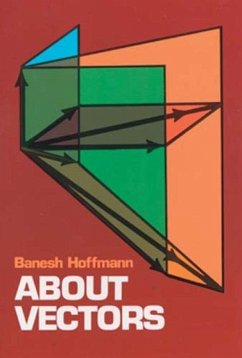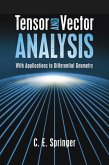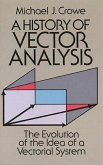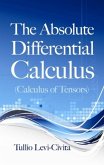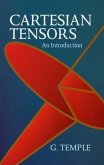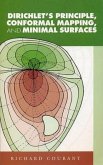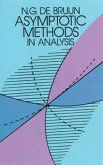Banesh Hoffmann
About Vectors
10,99 €
inkl. MwSt.
Versandfertig in über 4 Wochen

5 °P sammeln
Banesh Hoffmann
About Vectors
- Broschiertes Buch
- Merkliste
- Auf die Merkliste
- Bewerten Bewerten
- Teilen
- Produkt teilen
- Produkterinnerung
- Produkterinnerung
No calculus needed, but this is not an elementary book. Introduces vectors, algebraic notation and basic ideas, vector algebra and scalars. Includes 386 exercises.
Andere Kunden interessierten sich auch für
![Tensor and Vector Analysis Tensor and Vector Analysis]() C E SpringerTensor and Vector Analysis16,99 €
C E SpringerTensor and Vector Analysis16,99 €![Vector and Tensor Analysis Vector and Tensor Analysis]() George E HayVector and Tensor Analysis11,99 €
George E HayVector and Tensor Analysis11,99 €![A History of Vector Analysis A History of Vector Analysis]() Michael J CroweA History of Vector Analysis16,99 €
Michael J CroweA History of Vector Analysis16,99 €![The Absolute Differential Calculus (Calculus of Tensors) The Absolute Differential Calculus (Calculus of Tensors)]() Tullio Levi-CivitaThe Absolute Differential Calculus (Calculus of Tensors)22,99 €
Tullio Levi-CivitaThe Absolute Differential Calculus (Calculus of Tensors)22,99 €![Cartesian Tensors Cartesian Tensors]() G. TempleCartesian Tensors8,99 €
G. TempleCartesian Tensors8,99 €![Dirichlet's Principle, Conformal Mapping, and Minimal Surfaces Dirichlet's Principle, Conformal Mapping, and Minimal Surfaces]() Richard CourantDirichlet's Principle, Conformal Mapping, and Minimal Surfaces16,99 €
Richard CourantDirichlet's Principle, Conformal Mapping, and Minimal Surfaces16,99 €![Asymptotic Methods in Analysis Asymptotic Methods in Analysis]() N G de BruijnAsymptotic Methods in Analysis16,99 €
N G de BruijnAsymptotic Methods in Analysis16,99 €-
-
-
No calculus needed, but this is not an elementary book. Introduces vectors, algebraic notation and basic ideas, vector algebra and scalars. Includes 386 exercises.
Hinweis: Dieser Artikel kann nur an eine deutsche Lieferadresse ausgeliefert werden.
Hinweis: Dieser Artikel kann nur an eine deutsche Lieferadresse ausgeliefert werden.
Produktdetails
- Produktdetails
- Verlag: Dover Publications
- Seitenzahl: 144
- Erscheinungstermin: 1. Juni 1975
- Englisch
- Abmessung: 209mm x 144mm x 9mm
- Gewicht: 213g
- ISBN-13: 9780486604893
- ISBN-10: 0486604896
- Artikelnr.: 21508432
- Herstellerkennzeichnung
- Libri GmbH
- Europaallee 1
- 36244 Bad Hersfeld
- gpsr@libri.de
- Verlag: Dover Publications
- Seitenzahl: 144
- Erscheinungstermin: 1. Juni 1975
- Englisch
- Abmessung: 209mm x 144mm x 9mm
- Gewicht: 213g
- ISBN-13: 9780486604893
- ISBN-10: 0486604896
- Artikelnr.: 21508432
- Herstellerkennzeichnung
- Libri GmbH
- Europaallee 1
- 36244 Bad Hersfeld
- gpsr@libri.de
Banesh Hoffmann (1906-86) received his PhD from Princeton University. At Princeton's Institute for Advanced Study, he collaborated with Albert Einstein and Leopold Infeld on the classic paper "Gravitational Equations and the Problem of Motion." Hoffmann taught at Queens College for more than 40 years.
1 INTRODUCING VECTORS 1. Defining a vector 2. The parallelogram law 3.
Journeys are not vectors 4. Displacements are vectors 5. Why vectors are
important 6. The curious incident of the vectorial tribe 7. Some awkward
questions 2 ALGEBRAIC NOTATION AND BASIC IDEAS 1. Equality and addition 2.
Multiplication by numbers 3. Subtraction 4. Speed and velocity 5.
Acceleration 6. Elementary statics in two dimensions 7. Couples 8. The
problem of location. Vector fields 3 VECTOR ALGEBRA 1. Components 2. Unit
orthogonal triads 3. Position vectors 4. Coordinates 5. Direction cosines
6. Orthogonal projections 7. Projections of areas 4 SCALARS. SCALAR
PRODUCTS 1. Units and scalars 2. Scalar products 3. Scalar products and
unit orthogonal triads 5 VECTOR PRODUCTS. QUOTIENTS OF VECTORS 1. Areas of
parallelograms 2. "Cross products of i, j, and k" 3. "Components of cross
products relative to i, j, and k" 4. Triple products 5. Moments 6. Angular
displacements 7. Angular velocity 8. Momentum and angular momentum 9. Areas
and vectorial addition 10. Vector products in right- and left-handed
reference frames 11. Location and cross products 12. Double cross 13.
Division of vectors 6 TENSORS 1. How components of vectors transform 2. The
index notation 3. The new concept of a vector 4. Tensors 5. Scalars.
Contraction 6. Visualizing tensors 7. Symmetry and antisymmetry. Cross
products 8. Magnitudes. The metrical tensor 9. Scalar products 10. What
then is a vector? INDEX
Journeys are not vectors 4. Displacements are vectors 5. Why vectors are
important 6. The curious incident of the vectorial tribe 7. Some awkward
questions 2 ALGEBRAIC NOTATION AND BASIC IDEAS 1. Equality and addition 2.
Multiplication by numbers 3. Subtraction 4. Speed and velocity 5.
Acceleration 6. Elementary statics in two dimensions 7. Couples 8. The
problem of location. Vector fields 3 VECTOR ALGEBRA 1. Components 2. Unit
orthogonal triads 3. Position vectors 4. Coordinates 5. Direction cosines
6. Orthogonal projections 7. Projections of areas 4 SCALARS. SCALAR
PRODUCTS 1. Units and scalars 2. Scalar products 3. Scalar products and
unit orthogonal triads 5 VECTOR PRODUCTS. QUOTIENTS OF VECTORS 1. Areas of
parallelograms 2. "Cross products of i, j, and k" 3. "Components of cross
products relative to i, j, and k" 4. Triple products 5. Moments 6. Angular
displacements 7. Angular velocity 8. Momentum and angular momentum 9. Areas
and vectorial addition 10. Vector products in right- and left-handed
reference frames 11. Location and cross products 12. Double cross 13.
Division of vectors 6 TENSORS 1. How components of vectors transform 2. The
index notation 3. The new concept of a vector 4. Tensors 5. Scalars.
Contraction 6. Visualizing tensors 7. Symmetry and antisymmetry. Cross
products 8. Magnitudes. The metrical tensor 9. Scalar products 10. What
then is a vector? INDEX
1 INTRODUCING VECTORS 1. Defining a vector 2. The parallelogram law 3.
Journeys are not vectors 4. Displacements are vectors 5. Why vectors are
important 6. The curious incident of the vectorial tribe 7. Some awkward
questions 2 ALGEBRAIC NOTATION AND BASIC IDEAS 1. Equality and addition 2.
Multiplication by numbers 3. Subtraction 4. Speed and velocity 5.
Acceleration 6. Elementary statics in two dimensions 7. Couples 8. The
problem of location. Vector fields 3 VECTOR ALGEBRA 1. Components 2. Unit
orthogonal triads 3. Position vectors 4. Coordinates 5. Direction cosines
6. Orthogonal projections 7. Projections of areas 4 SCALARS. SCALAR
PRODUCTS 1. Units and scalars 2. Scalar products 3. Scalar products and
unit orthogonal triads 5 VECTOR PRODUCTS. QUOTIENTS OF VECTORS 1. Areas of
parallelograms 2. "Cross products of i, j, and k" 3. "Components of cross
products relative to i, j, and k" 4. Triple products 5. Moments 6. Angular
displacements 7. Angular velocity 8. Momentum and angular momentum 9. Areas
and vectorial addition 10. Vector products in right- and left-handed
reference frames 11. Location and cross products 12. Double cross 13.
Division of vectors 6 TENSORS 1. How components of vectors transform 2. The
index notation 3. The new concept of a vector 4. Tensors 5. Scalars.
Contraction 6. Visualizing tensors 7. Symmetry and antisymmetry. Cross
products 8. Magnitudes. The metrical tensor 9. Scalar products 10. What
then is a vector? INDEX
Journeys are not vectors 4. Displacements are vectors 5. Why vectors are
important 6. The curious incident of the vectorial tribe 7. Some awkward
questions 2 ALGEBRAIC NOTATION AND BASIC IDEAS 1. Equality and addition 2.
Multiplication by numbers 3. Subtraction 4. Speed and velocity 5.
Acceleration 6. Elementary statics in two dimensions 7. Couples 8. The
problem of location. Vector fields 3 VECTOR ALGEBRA 1. Components 2. Unit
orthogonal triads 3. Position vectors 4. Coordinates 5. Direction cosines
6. Orthogonal projections 7. Projections of areas 4 SCALARS. SCALAR
PRODUCTS 1. Units and scalars 2. Scalar products 3. Scalar products and
unit orthogonal triads 5 VECTOR PRODUCTS. QUOTIENTS OF VECTORS 1. Areas of
parallelograms 2. "Cross products of i, j, and k" 3. "Components of cross
products relative to i, j, and k" 4. Triple products 5. Moments 6. Angular
displacements 7. Angular velocity 8. Momentum and angular momentum 9. Areas
and vectorial addition 10. Vector products in right- and left-handed
reference frames 11. Location and cross products 12. Double cross 13.
Division of vectors 6 TENSORS 1. How components of vectors transform 2. The
index notation 3. The new concept of a vector 4. Tensors 5. Scalars.
Contraction 6. Visualizing tensors 7. Symmetry and antisymmetry. Cross
products 8. Magnitudes. The metrical tensor 9. Scalar products 10. What
then is a vector? INDEX
